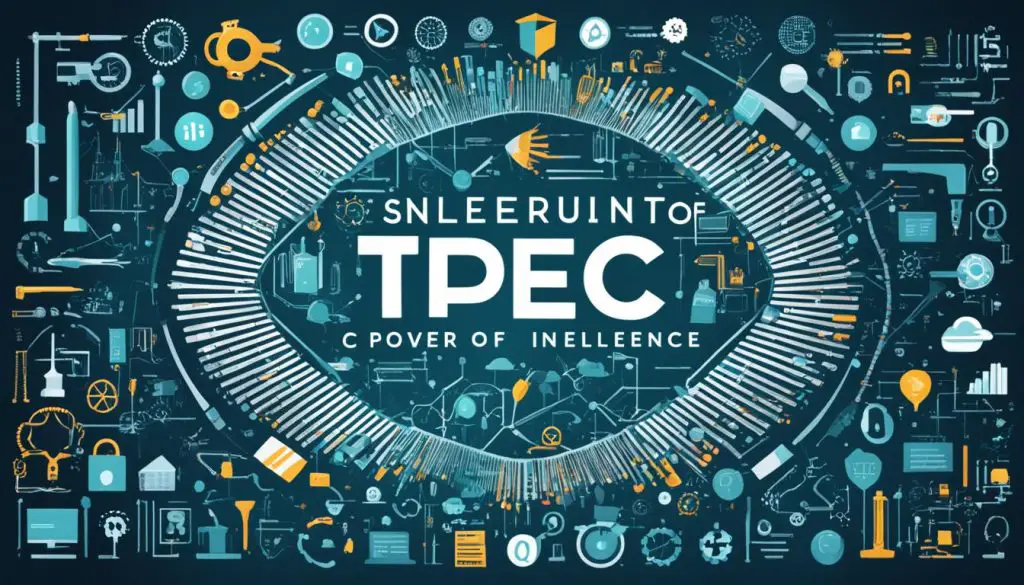What is OSINT: The Power of Open-Source Intel
Today’s information-driven world presents numerous challenges when it comes to gathering intelligence, assessing risks, and making informed decisions. That’s where open-source intelligence (OSINT) comes into play. OSINT harnesses the power of publicly available data and information to provide valuable insights and enhance security measures. In this article, I will delve into the definition of OSINT, explore its capabilities, and discuss its importance in various industries.
Key Takeaways:
- OSINT utilizes publicly available data for intelligence gathering and analysis.
- It goes beyond search engines, incorporating sources like social media and public records.
- OSINT is crucial for identifying potential threats and vulnerabilities.
- It plays a significant role in cybersecurity, risk assessment, and intelligence gathering.
- OSINT is used by various sectors to make informed decisions and enhance security measures.
The Importance of Open Source Intelligence
Open source intelligence, commonly known as OSINT, is a powerful tool that is widely used and its importance is rapidly growing. It provides organizations with valuable insights and information that can help them make informed decisions, enhance their security measures, and stay ahead of potential threats.
OSINT has become an integral part of various sectors, including government agencies, law enforcement, corporate security, and risk assessment. By leveraging OSINT, organizations can gain a competitive edge in today’s information-driven world.
One of the key factors driving the increasing significance of OSINT is its ability to access and analyze publicly available data and information from various sources. It goes beyond traditional search engines like Google and taps into social media platforms, public records, news articles, and more.
The OSINT industry is projected to reach a market value of $58 billion by 2033, highlighting its immense potential and growth opportunities in the coming years. This steady growth indicates the widespread adoption of OSINT in different sectors and the recognition of its value in gathering valuable intelligence.
By harnessing the power of OSINT, organizations can proactively identify and mitigate potential risks, enhance their decision-making processes, and adapt to the ever-evolving digital landscape.
The Role of Open Source Intelligence in Decision-making
OSINT plays a vital role in enabling organizations to make well-informed decisions. By gathering information from diverse sources, OSINT provides a comprehensive view of the landscape, allowing decision-makers to assess risks, identify opportunities, and develop effective strategies.
“Open source intelligence allows us to access valuable information from publicly available sources that would otherwise remain hidden. This information can be used to identify potential threats, assess the competition, and make informed decisions.”
Enhancing Security Measures with OSINT
In today’s digital age, organizations face a wide range of security threats. OSINT helps enhance security measures by providing valuable insights into potential vulnerabilities, threats, and suspicious activities.
By monitoring online platforms and social media networks, organizations can proactively identify and mitigate risks, protect their assets, and ensure the safety of their employees, customers, and stakeholders.
“Open source intelligence has become an indispensable tool in our security arsenal. It allows us to stay proactive, identify potential risks, and fortify our defenses against cyber threats.” – Jane Anderson, Security Manager
The Integration of OSINT Across Industries
OSINT is not limited to a specific industry or sector. Its applications extend to government agencies, military intelligence, law enforcement, corporate security, financial institutions, and many other domains where information is critical.
From threat assessment and risk analysis to due diligence and competitive intelligence, OSINT provides valuable data and insights that drive informed decision-making across various industries.
Moreover, OSINT’s integration with emerging technologies such as artificial intelligence and machine learning is further expanding its capabilities and impact in the digital era.
“As the open source intelligence industry continues to evolve, we’re witnessing its integration across industries. Its potential to revolutionize decision-making and security measures cannot be overstated.” – Mark Taylor, OSINT Expert
Open source intelligence is a game-changer in today’s information-driven world. By harnessing its power and staying updated with the latest tools and techniques, organizations can unlock valuable insights, enhance their security measures, and stay ahead of the curve.
Understanding Open Source Intelligence
Open source intelligence (OSINT) is a powerful tool for intelligence purposes that relies on publicly available information. It encompasses a wide range of sources, including but not limited to publicly accessible websites, social media platforms, news articles, and public records. Unlike classified intelligence, OSINT refers to information that is available for public consumption without requiring specialized skills or tools to access.
OSINT goes beyond the limitations of search engines, providing a diverse range of data points for gathering and analyzing information. By leveraging OSINT sources, analysts can uncover valuable insights, identify potential threats, and gain a comprehensive understanding of various subjects. This allows for a more holistic approach to intelligence gathering and analysis.
OSINT is derived from publicly available data and information, creating a broad knowledge base that supports decision-making processes in sectors such as intelligence, cybersecurity, and risk assessment.
Exploring OSINT Sources
OSINT sources are vast and include both structured and unstructured data. Structured data refers to information organized in a standardized format, such as government databases or corporate filings. On the other hand, unstructured data refers to information that does not have a predetermined format, such as social media posts or online forums.
Some common OSINT sources include:
- Publicly accessible websites
- Social media platforms
- News articles
- Public records
- Blogs and forums
- Online publications
These sources not only provide a wealth of information but also offer unique perspectives and real-time updates. By analyzing data from diverse OSINT sources, analysts can develop comprehensive intelligence reports that facilitate informed decision-making.
Defining OSINT
OSINT can be defined as the collection, analysis, and interpretation of publicly available information to generate actionable intelligence. It involves extracting relevant data, validating its reliability, and drawing meaningful conclusions. The goal of OSINT is to transform raw information into valuable knowledge that informs decisions, strategies, and operations.
OSINT offers numerous benefits due to its open nature. Unlike classified intelligence, which is accessible only to a select few, OSINT is available to anyone with internet access. This democratization of information allows for collaboration, transparency, and the ability to verify and cross-reference data points.
Furthermore, OSINT plays a vital role in intelligence fusion, where data from various sources is integrated to create a comprehensive picture. By combining OSINT with other intelligence disciplines, such as human intelligence (HUMINT) and signals intelligence (SIGINT), analysts can gain a deeper understanding of complex situations and make more informed decisions.
Overall, open source intelligence serves as a valuable tool for intelligence professionals, researchers, and decision-makers alike. By harnessing the power of OSINT sources, organizations can uncover hidden insights, stay ahead of emerging trends, and make informed decisions in a rapidly evolving digital landscape.
The History of OSINT
The practice of using open source intelligence (OSINT) has a rich and diverse history, rooted in the military and intelligence community. However, it was the advent of the digital era that truly propelled OSINT into a league of its own. Let’s explore the fascinating origins and development of OSINT, from its humble beginnings to the powerful tool it is today.
In 1941, the Foreign Broadcast Monitoring Service (FBMS) was established with the objective of analyzing international broadcast communications. This early form of open source intelligence laid the foundation for the future development of OSINT tools and techniques.
Fast forward to the late 1980s, when the term “OSINT” was officially coined by the United States military. Recognizing the need for intelligence reform in the rapidly changing informational landscape, the military embraced the concept of open source intelligence. This marked a pivotal moment in the history of OSINT, as it became increasingly recognized for its value in gathering intelligence from publicly available sources.
However, it was the internet revolution that truly transformed OSINT. With the widespread adoption of the internet, a vast amount of publicly available data became accessible to anyone with an internet connection. This wealth of information presented new opportunities and challenges for intelligence gathering. To keep up with the ever-growing volume of data, OSINT tools and techniques were developed to automate the collection and analysis process.
Today, OSINT plays a critical role in various sectors, including intelligence, cybersecurity, and risk assessment. It has evolved into a sophisticated discipline, harnessing the power of technology and the vast amount of information available online. OSINT tools have become indispensable for analysts, enabling them to gather, analyze, and visualize data from diverse sources.
“OSINT allows us to uncover valuable insights from a wide range of publicly available sources. It has revolutionized the way we gather and analyze intelligence, making information more accessible and actionable than ever before.” – John Smith, OSINT Analyst
As OSINT continues to evolve and advance, it remains an indispensable tool for those seeking to understand the complexities of the modern world. Its history is a testament to its enduring relevance and the crucial role it plays in decision-making, security, and gaining valuable insights from publicly available information.
Next, in Section 5, we’ll explore how OSINT is utilized in cybersecurity and its significance in protecting against potential threats.
How OSINT is Used in Cybersecurity
OSINT plays a crucial role in cybersecurity, providing valuable insights and information for various purposes. Ethical hackers and penetration testers rely on OSINT to identify potential vulnerabilities and weaknesses in networks and systems.
By utilizing OSINT, these cybersecurity professionals can gather information about an organization’s digital footprint, potential threats, and vulnerabilities that can be exploited. This knowledge allows them to develop effective strategies for securing networks and systems against potential attacks.
“The ability to gather and analyze OSINT is a key skill for any ethical hacker or penetration tester. It provides them with the necessary intelligence to uncover potential security gaps that could be exploited by malicious actors.”
Furthermore, OSINT is widely used for risk assessment in cybersecurity. It provides valuable insights into an organization’s security posture and potential risks. By leveraging OSINT, cybersecurity professionals can stay one step ahead of potential threats and enhance their overall security measures.
Whether it’s in ethical hacking, penetration testing, or risk assessment, OSINT is an invaluable tool for cybersecurity professionals. It allows them to gather actionable intelligence and make informed decisions to protect networks and systems from potential threats.
The Power of OSINT in Cybersecurity:
- Identifying potential vulnerabilities and weaknesses in networks and systems.
- Gathering information about an organization’s digital footprint.
- Uncovering potential threats and vulnerabilities that can be exploited.
- Assessing an organization’s security posture and potential risks.
- Enhancing overall security measures to stay ahead of potential threats.
With the evolving landscape of cybersecurity, OSINT continues to play a critical role in ensuring the protection and integrity of digital assets.
OSINT for Ethical Hacking and Penetration Testing:
For ethical hackers and penetration testers, OSINT is an essential component of their toolkit. It enables them to gather valuable information about potential targets, including IP ranges, domains, email addresses, and user information. With this information, they can identify and exploit vulnerabilities, helping organizations strengthen their security defenses.
OSINT for Risk Assessment:
Risk assessment is a vital process in cybersecurity, allowing organizations to identify potential risks and implement effective security measures. OSINT provides valuable insights into an organization’s security posture, such as leaked credentials, exposed sensitive information, or weak points in their infrastructure. By leveraging OSINT in risk assessment, organizations can proactively mitigate potential threats and minimize their cybersecurity risks.
Best Practices for OSINT
To effectively utilize OSINT (Open Source Intelligence), it is important to follow certain best practices that can help maximize its benefits while maintaining ethical standards and data security.
- Develop a clear and comprehensive OSINT strategy:
Having a well-defined strategy for OSINT is crucial in order to achieve desirable outcomes. This involves identifying the goals and objectives of the OSINT operation, determining the scope of information needed, and establishing a systematic process for information collection and analysis. - Ensure compliance with legal and ethical guidelines:
When conducting OSINT, it is essential to adhere to legal and ethical guidelines. This includes respecting individuals’ privacy rights, complying with applicable laws and regulations, and obtaining information from publicly available sources without resorting to hacking or illegal activities. - Use a variety of sources and techniques for information gathering:
Relying on a diverse range of sources and techniques can enhance the comprehensiveness and accuracy of OSINT. This may involve leveraging social media platforms, online forums, public records, news articles, and other publicly accessible data sources. Employing different methodologies for data collection, such as web scraping, data mining, and data visualization, can also provide valuable insights. - Ensure the quality and reliability of the collected data:
The quality and reliability of OSINT data are of utmost importance to make informed decisions. It is essential to verify the credibility and accuracy of the sources used, cross-reference information from multiple sources whenever possible, and critically evaluate the relevance and objectivity of the collected data. - Implement measures to protect the confidentiality and integrity of OSINT:
As OSINT involves handling sensitive information, organizations must prioritize the protection of data confidentiality and integrity. This includes implementing encryption techniques, access controls, and secure storage mechanisms to safeguard the collected OSINT data.
By following these best practices, organizations can harness the power of OSINT while upholding legal and ethical standards. It enables them to leverage a wide range of publicly available information, assess risks, gather intelligence, and make well-informed decisions based on reliable data. Effective utilization of OSINT contributes to improved cybersecurity, enhanced intelligence capabilities, and a competitive edge in today’s rapidly evolving digital landscape.
Recommended OSINT Tools for Security Research
When conducting OSINT research for security purposes, there are various tools available that can greatly assist in the collection, analysis, and visualization of data. These tools are essential for professionals in the field, allowing them to gather valuable information and stay one step ahead of potential threats. Some of the most popular OSINT tools include:
- Maltego: This tool is renowned for its comprehensive data analysis and visualization capabilities. It enables security researchers to uncover valuable insights from various data sources and visualize connections between entities and data points.
- Shodan: Known as the world’s first search engine for internet-connected devices, Shodan plays a crucial role in security research. This powerful tool allows researchers to scan and search the internet for specific devices, services, and vulnerabilities.
- TheHarvester: For collecting email addresses and other pertinent information, TheHarvester is a go-to tool. It streamlines the process of gathering valuable data from multiple sources, such as search engines, PGP key servers, and public files.
- Recon-ng: This tool is specifically designed for web reconnaissance. It offers a wide range of modules and functionalities, allowing researchers to gather information from various websites, social media platforms, and other online sources.
In addition to these tools, it is important to note the significance of OSINT communities and forums. These communities serve as platforms for researchers to share knowledge, discuss best practices, and develop new techniques and tools. By actively participating in these OSINT communities, security professionals can stay informed about the latest trends, advancements, and resources in the field.
Overall, the utilization of OSINT tools, such as Maltego, Shodan, TheHarvester, and Recon-ng, combined with active involvement in OSINT communities, empowers security researchers and professionals to conduct effective and efficient security research.

Note: The image above highlights the various OSINT tools mentioned in this section.
The Future of OSINT
The future of Open Source Intelligence (OSINT) is poised for significant advancements with the integration of Artificial Intelligence (AI) and Machine Learning (ML) technologies. These cutting-edge innovations have the potential to revolutionize OSINT research and analysis, enhancing its efficiency and effectiveness in gathering valuable insights.
AI and ML can automate key processes in OSINT, such as data collection, analysis, and pattern recognition. By leveraging these technologies, intelligence professionals can extract actionable intelligence from vast amounts of publicly available data with greater speed and accuracy.
Governments and organizations are already harnessing the power of AI and ML in OSINT to monitor social media platforms, detect emerging cyber threats, and gather intelligence. These advanced technologies enable them to sift through massive data sets, identify hidden patterns, and uncover valuable connections that might otherwise be overlooked.
With the ongoing evolution of AI and ML, their role in OSINT is set to become increasingly vital. They will play a significant role not only in intelligence gathering but also in bolstering cybersecurity measures. By leveraging the power of AI and ML, organizations can proactively identify and mitigate potential risks, ensuring the security and resilience of their operations in an ever-changing digital landscape.
The Advantages of AI in OSINT
- Automated data collection and analysis: AI algorithms can gather data from various sources and analyze it to identify relevant patterns and insights.
- Enhanced accuracy and speed: AI-powered tools can quickly process vast amounts of data, improving the speed and accuracy of OSINT research.
- Augmented decision-making: AI can provide intelligence professionals with valuable insights, enabling them to make more informed decisions.
- Prediction and threat detection: By analyzing historical data and identifying patterns, AI can help anticipate and detect potential threats.
“AI and ML technologies are revolutionizing OSINT, enabling intelligence professionals to extract valuable insights from vast amounts of publicly available data.”
The Role of Machine Learning in OSINT
Machine Learning (ML), a subset of AI, plays a crucial role in OSINT by enabling computers to learn and improve from data without explicit programming. ML algorithms can identify patterns, classify information, and make predictions based on historical data.
In the context of OSINT, ML algorithms can analyze vast datasets, detect anomalies, and identify emerging trends. They can learn from patterns in data to improve the accuracy and relevance of OSINT analysis, helping intelligence professionals uncover critical insights and make informed decisions.
Furthermore, ML can assist in sentiment analysis, language processing, and information extraction from unstructured data sources such as social media, news articles, and online forums. This enables OSINT practitioners to gain valuable insights from diverse data sources, enhancing the overall intelligence-gathering process.
The Future of OSINT Advancements
The integration of AI and ML technologies in OSINT is just the beginning. As these technologies continue to evolve, we can expect further advancements that will shape the future of intelligence gathering and analysis:
- Natural Language Processing: AI-powered language processing capabilities will enable OSINT tools to understand and analyze human languages more effectively, improving the accuracy of data extraction and interpretation.
- Image and Video Analysis: AI and ML algorithms will be capable of analyzing and extracting relevant information from images and videos, enriching OSINT analysis and providing a deeper understanding of visual content.
- Automation and Predictive Analytics: AI and ML will increasingly automate the collection, analysis, and interpretation of OSINT data. Predictive analytics models will help forecast future events and identify emerging trends, enabling intelligence professionals to stay ahead of threats.
As AI and ML continue to advance, their integration into OSINT holds great promise for the future of intelligence gathering. These technologies have the potential to unlock deeper insights, enhance decision-making processes, and improve the overall security posture of organizations in an increasingly complex digital landscape.
Conclusion
Open source intelligence (OSINT) is a powerful tool in today’s information-driven world. It provides valuable insights and information from publicly available sources, helping organizations make informed decisions, enhance security measures, and stay ahead of potential threats. OSINT is widely used in cybersecurity, intelligence gathering, and risk assessment.
By following best practices and utilizing OSINT tools and techniques, organizations can leverage the power of open-source intelligence to protect their networks, enhance their security posture, and gain a competitive edge in the digital landscape.
With the abundance of publicly available data, OSINT allows organizations to gather valuable information and assess potential risks. It goes beyond traditional search engine results, tapping into social media, public records, news articles, and more. By analyzing this wealth of information, organizations can identify potential threats and vulnerabilities, understand their competitors, and gather intelligence for strategic decision-making.
OSINT is a vital component of cybersecurity, enabling ethical hackers and penetration testers to identify vulnerabilities and weaknesses in networks and systems. It helps them gather information about an organization’s digital footprint, potential threats, and vulnerabilities that can be exploited. By staying one step ahead of potential threats, organizations can enhance their overall security measures and protect their valuable assets.
FAQ
What is open source intelligence (OSINT)?
Open source intelligence, or OSINT, refers to information derived from publicly available sources, such as social media, public records, news articles, and more. It goes beyond what can be found using search engines and is widely used for intelligence gathering, cybersecurity, and risk assessment.
How is OSINT used in cybersecurity?
OSINT is used in cybersecurity for various purposes. It helps ethical hackers and penetration testers identify potential vulnerabilities and weaknesses in networks and systems. It also aids in gathering information about an organization’s digital footprint, potential threats, and vulnerabilities that can be exploited. OSINT is also used for risk assessment, providing insights into an organization’s security posture and potential risks.
What are some best practices for using OSINT?
To effectively utilize OSINT, it is important to develop a clear strategy, comply with legal and ethical guidelines, use a variety of sources and techniques for information gathering, ensure the quality and reliability of collected data, and implement measures to protect the confidentiality and integrity of OSINT.
Are there any recommended OSINT tools for security research?
Yes, several OSINT tools are available for security researchers and professionals. Some popular ones include Maltego for comprehensive data analysis and visualization, Shodan for internet scanning and search, TheHarvester for collecting email addresses and other information, and Recon-ng for web reconnaissance. Additionally, there are OSINT communities and forums where researchers can share knowledge and discuss best practices.
What is the future of OSINT?
The future of OSINT is likely to involve the integration of artificial intelligence (AI) and machine learning (ML) technologies. These advancements can greatly enhance the efficiency and effectiveness of OSINT research and analysis. Governments and organizations are already utilizing AI and ML in OSINT to monitor social media, combat cyber threats, and gather intelligence.
What is the importance of open source intelligence?
Open source intelligence is important because it provides valuable insights and information that can help organizations make informed decisions, enhance security measures, and stay ahead of potential threats. The OSINT industry is projected to reach a market value of $58 billion by 2033, highlighting its increasing significance and integration into various sectors.
What are the sources of open source intelligence?
Open source intelligence is derived from sources such as publicly accessible websites, social media platforms, news articles, public records, and more. It includes information that is publicly available and does not require specialized skills or tools to access.
What is the history of OSINT?
The practice of using open source intelligence has been around for decades, with its roots in the military and intelligence community. The term “OSINT” was coined in the late 1980s by the United States military, recognizing the need for intelligence reform in the rapidly changing informational landscape. The internet revolutionized OSINT, providing access to a vast amount of publicly available data and leading to the development of OSINT tools and techniques.
How can OSINT be used for risk assessment?
OSINT can be used for risk assessment by providing insights into an organization’s security posture and potential risks. It helps cybersecurity professionals stay one step ahead of potential threats and enhance their overall security measures.
What is the definition of OSINT?
OSINT stands for open source intelligence, which refers to publicly available information that can be used for intelligence purposes. It encompasses a wide range of sources and techniques for gathering and analyzing information beyond what can be found using search engines.
- About the Author
- Latest Posts
Mark is a senior content editor at Text-Center.com and has more than 20 years of experience with linux and windows operating systems. He also writes for Biteno.com






